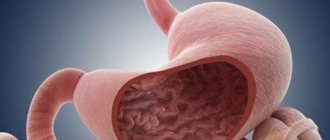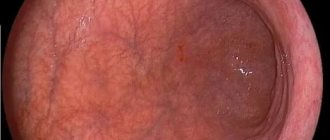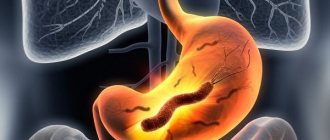What is granular gastritis?
Doctors distinguish many types of inflammation of the gastric mucosa, among which granular gastritis should be distinguished. This disease gets its name because small growths form on the walls of the stomach. Recently, this pathology is being diagnosed more and more often. Initially they are small, but as they progress they cover an increasingly larger area. This pathology mainly occurs in men over 40 years of age.
Doctors distinguish many types of inflammation of the gastric mucosa, among which granular gastritis should be distinguished
Modern medicine classifies this disease into several main forms. The least common type is granular antral gastritis. During an exacerbation of the pathological process, excessive accumulation of mucus in the stomach, disruption of the digestive process and a significant narrowing of the antral space are observed. In addition, there is severe swelling of the mucous membrane and increased acidity.
Another type is hyperplastic gastritis, which is characterized by the formation of rough growths on the gastric mucosa. Violations are mainly observed in the antrum. At the initial stage of the disease, pathological processes practically do not manifest themselves at all. Over time, a feeling of heaviness, belching, and heartburn appears. At the initial stage, granular gastritis does not manifest itself at all.
However, as the disease progresses, the number of tumors increases sharply, and quite pronounced signs appear, in particular:
- painful sensations between the ribs;
- nausea and vomiting;
- prolonged diarrhea.
With the rapid progression of the disease, the patient loses appetite, which leads to very slow depletion of the body. The danger of the disease is that there is a possibility of internal bleeding.
Before starting treatment for granular gastritis, it is important to undergo a comprehensive examination, which will help determine what exactly triggered the disease. Based on the data obtained, an individual course of therapy is selected.
If the test results are positive for the presence of bacteria in the body, the doctor prescribes antibacterial therapy. In addition, you must adhere to a dietary diet. You need to exclude irritating foods from your usual diet. For therapy to bring a positive result, the patient needs to create the most comfortable psychological conditions.
Causes of the disease
It is impossible to fully determine the main cause of granular gastritis. Most often, this disease affects males over 40 years of age who have a history of several predisposing factors.
What can cause this pathology:
- Wrong lifestyle. This includes the presence of bad habits, a tendency to eat low-quality food, and lack of exercise.
- Other diseases. Sometimes the cause of granular gastritis is dental problems, endocrine disorders, helminthic infestation or an inflammatory process in any part of the digestive tract.
- Nervous overstrain. The disease provokes not only regular stress, but even a single emotional shock.
- Other internal reasons. This includes chronic vitamin deficiency, hereditary predisposition, and food allergies.
Inflammation of the stomach is also caused by single or multiple poisonings with chemicals, drugs and other products harmful to health.
What is granular gastritis
Granular gastritis is characterized by inflammation of the gastric mucosa, but unlike other forms of gastritis, with the granular type, small neoplasms appear on the walls of the affected organ, no more than one centimeter in circumference. Over time, folds appear between these neoplasms, in which gastric juice and other enzymes accumulate, resulting in the destruction of the mucous membrane and inner walls of the stomach.
At the initial stages of the development of the disease, granular gastritis is practically asymptomatic, which makes it difficult to diagnose and prevent its development. But in the last stages, when folds are already forming between the neoplasms, the symptoms begin to become pronounced, as the enzymes produced by the stomach begin to “eat” themselves from the inside. During this period, the patient feels pain in the upper abdomen, sometimes accompanied by fever and increased salivation. Nausea and vomiting are very common, occurring quite suddenly and sometimes in the wrong place. The patient also experiences worsening appetite, sleep disturbances, and general weakness.
Treatment of granular gastritis is no different from treatment of other types of gastritis. Basically, it includes taking antibiotics and, if necessary, enzyme substances, as well as following a strict diet, giving up bad habits and creating conditions under which the patient will be surrounded by care and attention, and will not be under emotional stress.
If all therapeutic measures do not bring positive dynamics, it is possible to use a surgical treatment method. You should not treat gastritis on your own without the knowledge of a doctor, as this can provoke the development of complications.
Granular gastritis is dangerous because it provokes swelling of the mucous membrane, disrupts metabolism in the body and leads to complicated digestion of food.
Granular gastritis is dangerous because it provokes swelling of the mucous membrane, disrupts metabolism in the body and leads to complicated digestion of food. But in addition to all this, this pathology can cause gastric bleeding, which leads to death, as well as the development of tumors, which may require gastric resection.
Types of granular gastritis:
- antral gastritis: this type occurs in a third of patients with granular gastritis. During an exacerbation, an excessive amount of mucus and water accumulates in the organ. His tone decreases. The antrum becomes narrower and shortens. The walls swell. There are a large number of Helicobacter bacteria. With the disease, acidity in the stomach increases. The treatment is long-term (it lasts at least two months);
- hyperplastic gastritis: neoplasms are present on the walls of the organ. Their size is 1 mm. The folds of the stomach become rough. The lesion is present on its posterior part. This form of the disease is distinguished by the absence of symptoms in the early stages of development. Subsequently, the patient begins to experience pain, belching, nausea and vomiting.
Symptoms
At an early stage of development, granular gastritis most often occurs without noticeable manifestations. Subsequently, the following symptoms appear:
- Pain in the epigastric region (usually on an empty stomach).
- Nausea, vomiting.
- Heartburn, belching.
- Bloating.
- Increased gas formation.
- Stool disorders (diarrhea is replaced by constipation).
- Excessive salivation.
- Decreased appetite.
- Loss of body weight.
- Fatigue, weakness.
- Insomnia.
A long course of granular gastritis can cause complications:
- gastric bleeding leading to anemia;
- decreased production of hydrochloric acid and poor digestion of food, which leads to a deficiency of vitamins and microelements in the body;
- severe swelling of the soft tissues of the whole body, resulting from a lack of protein;
- malignancy (degeneration into cancer).
Treatment of granular gastritis
In most cases, the term “granular gastritis” is used to describe the endoscopic picture that a functional diagnostics doctor sees when performing fibrogastroduodenoscopy. It is characterized by focal changes in the mucosa in the form of small protrusions. Treatment of hypertrophic granular gastritis is symptomatic, since the cause of the disease is not clear.
The basis of therapy is:
- use of antibiotics: with a positive test for Helicobacter pylori (clarithromycin, amoxicillin);
- enzyme preparations: to improve digestion (Mezim, Creon);
- antispasmodics: to reduce pain (no-spa);
- rational diet therapy: avoiding fatty, fried, spicy foods, eating small portions - 4-5 times a day;
- quitting smoking and drinking alcohol;
- creating maximum psychological comfort: – avoid stress, normalize work and rest, sleep at least 8 hours a day, spend more time in the fresh air.
Diet for the treatment of granular gastritis
The diet for the treatment of granular gastritis must be varied and balanced in composition, containing all the necessary vitamins and minerals.
The success of the treatment directly depends on the strict adherence to nutritional recommendations. The choice of diet for granular gastritis varies depending on the degree of acidity of gastric juice.
General dietary recommendations for granular gastritis:
- food must be chewed thoroughly, food must be eaten slowly;
- food portions should be small;
- 5-6 meals a day are welcome;
- the diet should be varied and balanced in composition, contain all the necessary vitamins and minerals;
- food should be warm (too high or low temperature irritates the mucous membrane);
- Flour, fried, spicy, smoked and canned foods are prohibited;
- it is necessary to give up alcohol, smoking, coffee;
- Cooking methods such as boiling and stewing are welcome;
- with low acidity, use rich broths, sweet and sour fruits, mineral water without gases, which is prohibited with high acidity.
This type of gastritis is dangerous due to its complications; hypertrophy of the mucous membrane can provoke gastric bleeding or the development of tumors, so you should not delay consulting a doctor at the slightest suspicion of the onset of the disease.
Prognosis and prevention
With such a diagnosis, the patient will be forced to visit a gastroenterologist for the rest of his life. This is necessary for prevention and early detection of complications if they arise.
The presence of granular gastritis in close relatives is a reason to reconsider lifestyle and eating habits in order to prevent the transmission of the disease by inheritance.
After the main treatment, you will need to give up bad habits, improve your diet and periodically attend preventive examinations. With timely diagnosis, it is possible to immediately influence the disease and prevent it from progressing further.
Granular gastritis treatment and diet
One of the rare types of inflammation of the mucous membrane, of which there are more than twenty in total, is granular gastritis. It received its name due to the formation of small protrusions 3-5 mm in size, the so-called “grains”, on the surface of the inner lining of the stomach during inflammation.
It is possible to see and qualify this type of inflammation of the mucous membrane only with a complete endoscopic examination, including fluoroscopy. The danger of granular gastritis lies in its transformation during further development into an ulcer or cancerous tumor. The causes of the occurrence and development of this type of gastrointestinal disease such as granular gastritis are not known exactly. This may be the influence of unfavorable factors acting from outside, or perhaps a hereditary predisposition. Most often, this type of disease is diagnosed in men over 40 years of age. In the initial stage, the disease may occur without obvious symptoms.
Treatment of granular gastritis is not very different from the therapy used for other gastrointestinal diseases. First of all, it is necessary to stop drinking all types of alcohol and smoking, which provoke an exacerbation of the disease. An important role is played by a favorable psychological climate, when a normal work and rest schedule is established, the absence of stress, a passion for being in the fresh air, and playing sports.
If the disease is caused by Helicobacter pylori bacteria, antibiotics are prescribed. The most important and basic treatment is diet.
When prescribing a diet for granular gastritis, during the period of illness, food must be chewed thoroughly and slowly, and portions for each meal should be small in volume.
When prescribing a diet for granular gastritis, during the period of illness, food must be chewed thoroughly and slowly, and portions for each meal should be small in volume. Proper nutrition from a chemical point of view means a set of essential vitamins, minerals, proteins, and so on. The temperature regime of the food eaten should be gentle, that is, it should not be hot or cold.
The diet for granular gastritis is prescribed based on the level of acidity, and in case of exacerbation, special nutrition is required. Treatment of gastritis of the stomach includes the use of mineral waters. Specific types of mineral water and the scheme for their use are prescribed by a nutritionist. Based on the characteristics of the disease, the course of treatment lasts for 3-4 weeks and it is recommended to repeat the course two to four times throughout the year.
Folk remedies that have been tried for decades, including herbal medicine, are very useful for granular gastritis. Bitter infusions made from wormwood, three-leaved wachtweed, curly thistle, and orange peel improve the secretion of gastric juice in granular gastritis. Juices of aloe, black currant, and chokeberry are used with reduced acidity.
Diagnostics
To diagnose granular gastritis, a comprehensive examination is prescribed:
- General examination with palpation of the abdomen.
- Collecting a detailed medical history.
- Blood tests (general and biochemical).
- Stool tests for blood and the presence of the bacterium Helicobacter pylori.
- Urine analysis to determine acidity level.
- Fibrogastroduodenoscopy with biopsy sampling for histological examination.
- Radiography.
- Esophagofibrogastroduodenoscopy.
- Ultrasound.
- Probing of the stomach and duodenum.
- pH-metry.
Granular gastritis
Inflammation is considered focal when not the entire gastric mucosa is affected, but only a certain part of it. At first, the manifestations of such inflammation are no different from the general signs of gastritis. The patient may complain of nausea, burning sensation and pain in the epigastric region, and changes in stool.
The doctor will tell you what measures need to be taken immediately, and you need to see him as soon as possible. The cause of both antral and chronic focal gastritis is the bacteria Helicobacter pylori, but if in the first case we are talking mainly about the increased acidity of the gastric contents, then in the second case the acidity may be reduced.
There are several subtypes of chronic focal gastritis. An accurate determination will allow the doctor to prescribe the optimal set of therapeutic measures and will significantly speed up the recovery process. Only after the type of chronic focal gastritis, the type of gastric secretion and the phase of the disease have been accurately established, will the attending physician be able to prescribe treatment adequate to the patient’s condition. As a rule, you can be treated at home, but if the disease worsens, it is still better to go to the hospital.
Drug treatment is prescribed exclusively during the acute phase and is carried out strictly under the supervision of the attending physician. Great attention is paid to diet and nutrition. For example, if the acidity of the stomach is increased, the most gentle diet is recommended. In cases where gastric secretion, on the contrary, is reduced, a diet is prescribed that is gentle from a mechanical point of view, but can chemically stimulate the secretory function. For this, the patient is recommended to have strong broths, soups, baked or fried lean meats and fish, vegetables, fruits and juices, as well as cocoa. It is very important to chew your food as thoroughly as possible.
Drug treatment is prescribed exclusively during the acute phase and is carried out strictly under the supervision of the attending physician. Physiotherapy is also used during an exacerbation, effectively stimulating secretion, reducing the severity of clinical manifestations, improving motor function of the stomach and normalizing blood supply to the mucous membrane.
A huge role in the prevention of chronic focal gastritis is played by sanatorium-resort treatment, namely drinking mineral waters. An interesting fact is that doctors previously recommended that patients with high stomach acidity go to resorts where sources of alkaline water prevail. Conversely, people with secretory insufficiency were persistently advised to go to places where they could drink salt and salt-alkaline waters.
Diet
A prerequisite for treatment is the patient's compliance with the diet. Otherwise, even after a course of drug treatment, exacerbations and relapses of the disease will occur. It is necessary to exclude from the diet:
- tea and coffee;
- carbonated drinks;
- fatty and spicy foods;
- seasonings and spices;
- canned foods and marinades;
- chocolate;
- alcohol;
- sausages and sausages;
- baked goods.
The patient should eat in small portions, chewing food thoroughly. It is imperative to drink mineral water for 3-4 weeks.
You can use traditional medicine recipes. Decoctions of chamomile and calendula have a beneficial effect on the stomach. To increase appetite and restore microflora, it is recommended to drink decoctions of tansy and wormwood. You can eat chokeberry and drink aloe juice every day.
You must include in your diet:
- poultry, beef and veal;
- pureed soups made with oatmeal, buckwheat, and rice;
- kefir, fermented baked milk, yogurt;
- low-fat fish;
- dried fruits compote;
- jelly;
- porridge;
- eggs boiled or in the form of an omelet;
- baked apples.
Granular gastritis is dangerous because in its advanced form gastric bleeding is possible, as well as the development of cancerous tumors. Therefore, at the slightest suspicion of illness, you should consult a doctor.
Not every person knows what granular gastritis is. The disease can be characterized as a deformation of the mucous membrane, which can only be seen using fibrogastroduodenoscopy. The disease has earned this name due to its morphological manifestations, however, despite this, many experts believe that granular gastritis is a form of hypertrophic gastric disease.
Antral and hyperplastic granular gastritis: treatment and diagnosis
The main danger of granular gastritis is the high risk of developing into cancer.
At the moment, experts identify several types of granular gastritis. They all differ in form, manifestations, and required treatment.
Granular gastritis has the following forms:
- antral: diagnosed in 30% of cases. The disease is characterized by the formation of large amounts of mucus and fluid in the stomach. The tone of the organ is significantly reduced, while the antrum is shortened and narrowed. The mucous membrane becomes swollen and contains about 90% of Helicobacter. At the same time, the antral form of granular gastritis is characterized by increased acidity. The duration of treatment is usually about 3 months;
- hyperplastic: the surface of the gastric mucosa is covered with numerous tubercles, the size of which does not exceed 1 millimeter. The folds of the organ themselves become coarsened, and foci of exacerbation spread to the posterior wall of the stomach and the antrum. The greatest danger of this disease is that it does not show any symptoms for a long time. Over time, a person begins to complain of nausea, heartburn, and belching.
The main danger of this disease is that granular gastritis may not manifest itself with any distinctive symptoms over a long period of time. The first signs of pathology appear already in advanced stages, when complications develop. As gastritis develops, it causes the formation of numerous erosions and cysts in the stomach.
Granular gastritis requires extensive diagnostics. For an initial examination, the doctor sends the patient for a general examination, after which he collects an anamnesis. Also, at the initial appointment, the specialist carefully palpates the abdomen and checks all internal organs. After this, radiography, fibrogastroscopy and esophagofibrogastroduodenoscopy are performed. It is very important to determine the level of stomach acidity. This is necessary to determine the correct treatment tactics.
It is very important to determine the level of stomach acidity. This is necessary to determine the correct treatment tactics
In order for the treatment of granular gastritis to be as effective as possible, it must be prescribed exclusively by a qualified attending physician. He will be able to do this solely on the basis of diagnostic data.
Typically, therapy for granular gastritis involves taking the following medications:
- antibiotics: suppress the activity of not only Helicobacter, but also other pathogenic microorganisms that arise in the stomach against the background of rotting;
- drugs that reduce the production of gastric juice;
- enzymes that improve the digestion process;
- antispasmodics, which relieve a person from painful sensations.
After the specialist manages to normalize the functioning of the stomach, medications are prescribed that accelerate the regeneration process. This is necessary to restore damaged mucosa, as well as relieve ulcers on the surface of the stomach.
Features of the development and course of the disease
A distinctive feature of granular gastritis from other forms of the disease is the formation of growths on the inner surface of the stomach, usually not exceeding 1 cm in size, often 3-6 mm.
In advanced cases, there is an active growth in the size and number of tumors, which significantly affects the general well-being of the patient and leads to serious disturbances in the functioning of the stomach. In medicine, it is customary to distinguish two types of granular gastritis:
- Granular antrum, in which the stomach is in poor tone and there is a noticeable accumulation of mucus and water. The mucous membrane itself has pronounced swelling, the antrum of the digestive organ is noticeably narrowed and shortened. Determination of the acidity level in most cases shows an excess of the norm; about 90% of Helicobacter bacteria, which can provoke the development of peptic ulcers, are detected. Treatment of acute gastritis usually lasts at least 2.5 months.
- Granular hyperplastic is characterized by the presence of millimeter-sized rough tubercles throughout the entire internal area of the mucous membrane. A large number of growths leads to a loss of elasticity of the gastric tissue, which becomes very rough. The initial stage of this type of gastritis is asymptomatic, only as the disease progresses does the patient experience frequent belching, heartburn, and heaviness in the abdomen.
External factors contributing to the development of pathology:
- systematic overeating, predominance of unhealthy foods in the diet;
- lack of a meal plan, too long gaps between meals;
- abuse of alcoholic beverages, which strongly irritate the gastric mucosa, smoking;
- prolonged stressful situations, nervous overstrain;
- taking certain medications that have an aggressive effect on the microflora of the stomach, worsening the functioning of the digestive organs.
Granular gastritis can be a consequence of other serious diseases that a person has, for example, hormone imbalance, diabetes; vitamin deficiency and radiation exposure contribute to the development of the disease.
The insidiousness of the disease lies in its practically asymptomatic course in the initial stages, so when the patient nevertheless consults a doctor, the granularity already has a pronounced character. Increased production of gastric juice leads to increased inflammation in the stomach, hydrochloric acid, acting on the mucous membrane, provokes severe pain in the upper abdomen, a noticeable increase in salivation, and the patient’s temperature may rise. Frequent manifestations of the disease are a sudden feeling of nausea, vomiting, poor appetite, poor sleep, and decreased performance.
The progressive granular form of gastritis over time leads to disruption of metabolic processes in the body and the inability to digest food normally. In severe cases, internal bleeding occurs, which can lead to death. Doctors often associate the development of malignant tumors with advanced granular gastritis.
Why is granular gastritis dangerous?
Granular gastritis is a serious disease, the danger of which is a high risk of complications. Against the background of swelling of the mucous membrane, gastric motility may be impaired. This causes serious deviations in metabolic processes, which also disrupts metabolism. Granular gastritis can easily cause internal gastric bleeding. If you do not respond to this problem in a timely manner, death may occur. In this case, it is necessary to immediately perform gastric resection.
Granular gastritis is treatable if diagnosed in the early stages. Only with an integrated approach will you be able to prevent complications from occurring. The particular danger of this pathology is that it can easily lead to stomach tumors.
Granular gastritis is a disease that, if treated incorrectly, can lead to the development of serious complications. Due to hypertrophy of the gastric mucosa, bleeding may occur or a tumor may form. It is for this reason that when the first signs of pathology appear, you should immediately consult your doctor.
Sources:
- https://gastritinform.ru/xozyaika.com/zernistyj-gastrit-vidy-simptomy-lechenie-i-dieta/
- https://zhkt.ru/zheludok/gastrit/zernistyj.html
- https://gastritinform.ru/gastromedic.ru/gastrit/zernistyj-gastrit.html
- https://zhkt.guru/gastrit/vidy/zernistyy-1
- https://www.passion.ru/health/zhkt/hronicheskiy-ochagovyy-gastrit-86156.htm
- https://gastrit.guru/lechenie/zernistyj-gastrit.html
How to detect the presence of gastritis in the stomach?
After contacting a gastroenterologist, the patient will have to undergo a series of studies and tests. The first thing the doctor will do is collect anamnesis, listen to the patient’s complaints and conduct a general examination. The following would be appropriate:
- X-ray examination;
- Esophagofibrogastroduodenoscopy - the procedure can determine the level of acidity. During this procedure, probing is carried out and bile is collected for subsequent examination or histology;
- Acidotest - the procedure is performed if there are contraindications to the use of the probe. Biological material is collected after the patient takes a special drug;
- Fibrogastroscopy. Using a special optical device, the appearance of the stomach is examined. Thanks to the procedure, the doctor can identify the exact form of gastritis and the severity of its development. If the cysts reach two cm, then the patient is affected by granular gastritis, if the folds are larger - hypertrophic; in the presence of warty growths we are talking about warty gastritis, in the presence of polyps - about polyposis;
- A respiratory test or stool test to detect Pylori bacteria.
Types of hypertrophic gastritis
According to the degree of change in the mucous membrane, the following subtypes of hypertrophic gastritis are distinguished:
- granular form - with it cysts are found on the mucous membrane;
- polypous gastritis - polyps are found on the mucous membrane;
- warty hypertrophic gastritis - warts are detected on the mucous membrane;
- Ménétrier's disease - when large folds are found on the mucous membrane - there are three types (asymptomatic, pseudo-tumor, dyspeptic).
The listed growths are located in groups or individually. Based on localization, the disease is divided into focal and diffuse gastritis. In focal cases, damage occurs only in certain places of the mucous membrane. With diffuse, its entire surface is damaged.











